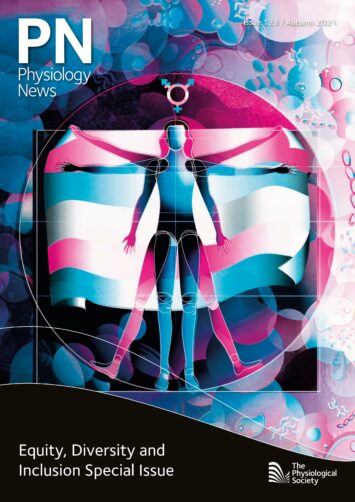
Physiology News Magazine
President’s View: Launch of The Society’s new blue plaque scheme
News and Views
President’s View: Launch of The Society’s new blue plaque scheme
News and Views
https://doi.org/10.36866/pn.123.6
Professor David Paterson, President, The Physiological Society
In June I was delighted to launch The Physiological Society’s new commemorative blue plaque scheme. This initiative honours outstanding physiologists who have contributed to the advancement of physiology through their discoveries, while leaving a legacy beyond their lifetime.
With the blue plaques we aim to increase the prestige associated with the university departments, demonstrating the legacy of physiology academia to potential students as well as raising the visibility of physiology, giving the wider public an insight into the positive role that “the science of life” plays in their everyday lives.
The first plaque was unveiled at the University of Oxford’s Department of Physiology, Anatomy & Genetics building, and honours the heritage of pioneering physiologist Sir Charles Sherrington. Sherrington is widely celebrated as the neurophysiologist who shaped our understanding of the central nervous system. He came to the University of Oxford’s Laboratory of Physiology as the Waynflete Professor of Physiology in 1913 and received the Nobel Prize in Physiology or Medicine in 1932 with Edgar Adrian for their work on the functions of neurons. Prior to the work of Sherrington and Adrian, it was widely accepted that reflexes occurred as isolated activity within a reflex arc; instead, Sherrington and Adrian showed that reflexes require integrated activation and demonstrated reciprocal innervation of muscles, a principle now known as Sherrington’s Law.
Sherrington’s blue plaque was unveiled by Professor Sir Colin Blakemore, the first President of The Physiological Society and the longest-serving Waynflete Professor of Physiology at Oxford.
Over the coming months, a series of commemorative blue plaques will be unveiled at academic institutions across the UK and Ireland. I hope they will spark curiosity and help inspire new generations to get involved in the physiological sciences.
More information about the blue plaque and Sherrington, including archive footage, can be found at
physoc.org/about-us/our-blue-plaques/.
COVID-19 recovery: Visibility, inclusivity and sustainability
Earlier this summer The Society held an event in partnership with the Parliamentary & Scientific Committee to discuss the role of science in the UK’s recovery from COVID-19. I was pleased to speak alongside representatives from the Department of Business, Innovation and Skills, AstraZeneca, and the Confederation of British Industry.
I highlighted how I believe the Government should align its recovery to the same core themes as we focus on at The Society: visibility, inclusivity, and sustainability.
Visibility
While COVID-19 is our short-term priority, long-term societal challenges such as our ageing society have not gone away. The demographic challenges facing the UK are stark, with the number of people aged 65 and over set to increase by more than 40% within 20 years.
As we enter the fourth industrial revolution of precision medicine and genomics, the challenge becomes not prolonging lifespan but ensuring our healthcare systems are set up to maximise health span.
That means increasing the visibility across government, funders, and public policy of the vital importance of understanding the physiology at play. Within R&D, we need to see more funding directed towards the biological processes of ageing, and within
public policy we need greater profile given to physiological age, considering healthy ageing across the whole life course. Greater visibility of physiological mechanisms will improve the quality of public health interventions and medical treatment that can help us live better for longer.
Inclusivity
Our research communities must become more inclusive of a wider range of voices and perspectives. All of us involved in science have a responsibility to redouble efforts to promote diversity – not only gender, but also other protected characteristics.
Sustainability
The UK punches above its weight in R&D, but it is not possible to turn science on and off like a tap. The delivery of COVID-19 vaccines in less than 12 months was made possible by at least a decade of underpinning science and mechanistic understanding. A thriving fundamental research base is essential for a booming life science economy – we cannot afford to let this go.
The Government has “talked the talk” on science with bold commitments to spend £22 billion on R&D by 2025 and increase total R&D spend to 2.4% of GDP by 2027. We now need to see them translate this positive narrative into meaningful actions.
Scientific research operates in a complex ecosystem and the COVID-19 pandemic has exposed stress points, particularly around the quality-related research (QR) funding model for English universities. Medical research charities account for half of publicly funded medical research in the UK but have been forced to cut on average 41% of research spend as philanthropic funding dries up.
COVID-19 has exacted a terrible toll on life and livelihoods. And this will not be the last pandemic. From climate change to our ageing society, the challenges we face in the years ahead are multiple and vast. The vaccination drive has shown what can be achieved when political will aligns with scientific prowess and public determination. By grasping the opportunity to put R&D at the heart of post- COVID-19 recovery, policymakers can unlock the UK’s potential. With our sights set on cementing our role as
a science superpower, the UK can not only recover, but we can build a stronger economy, safer society, and more optimistic future.
